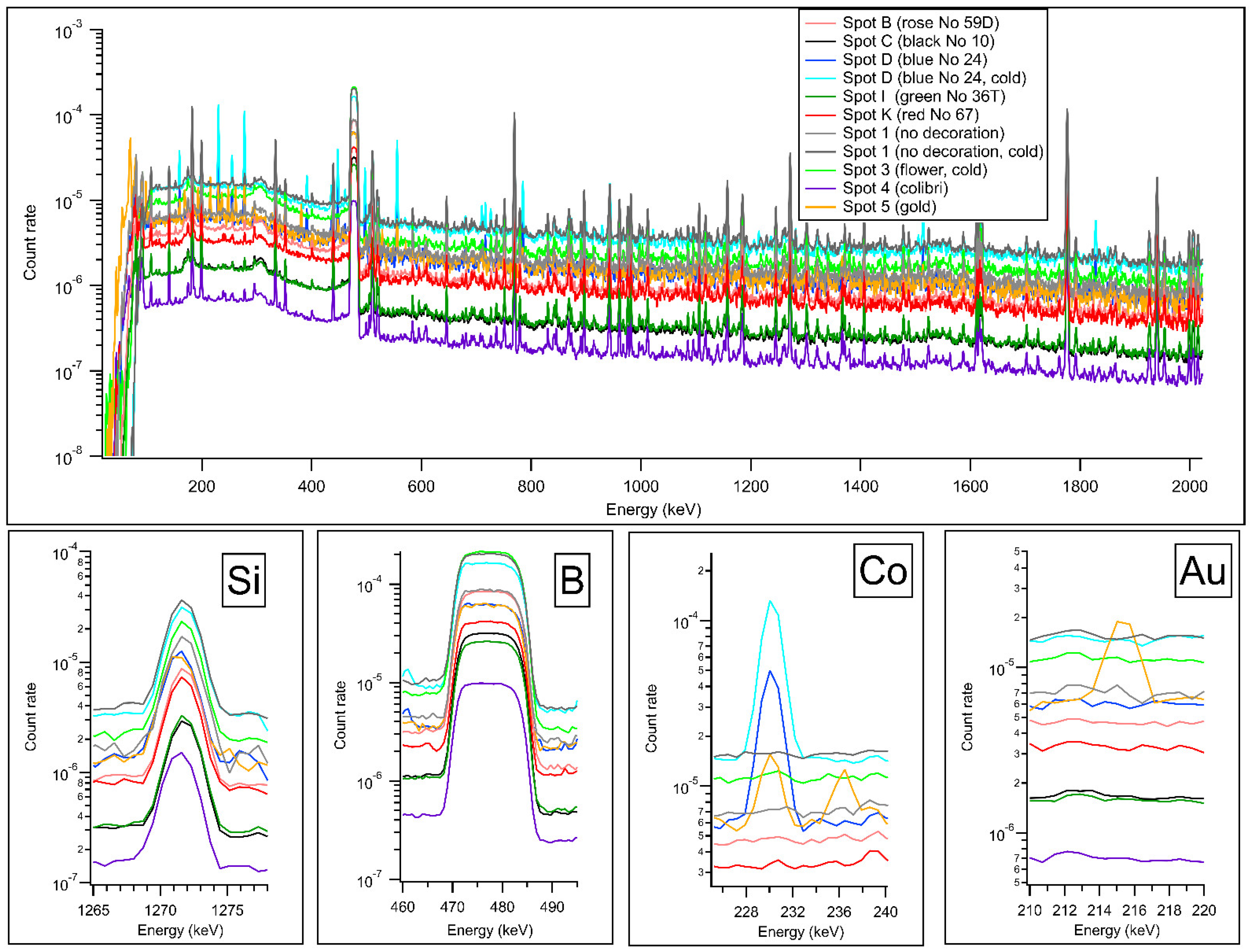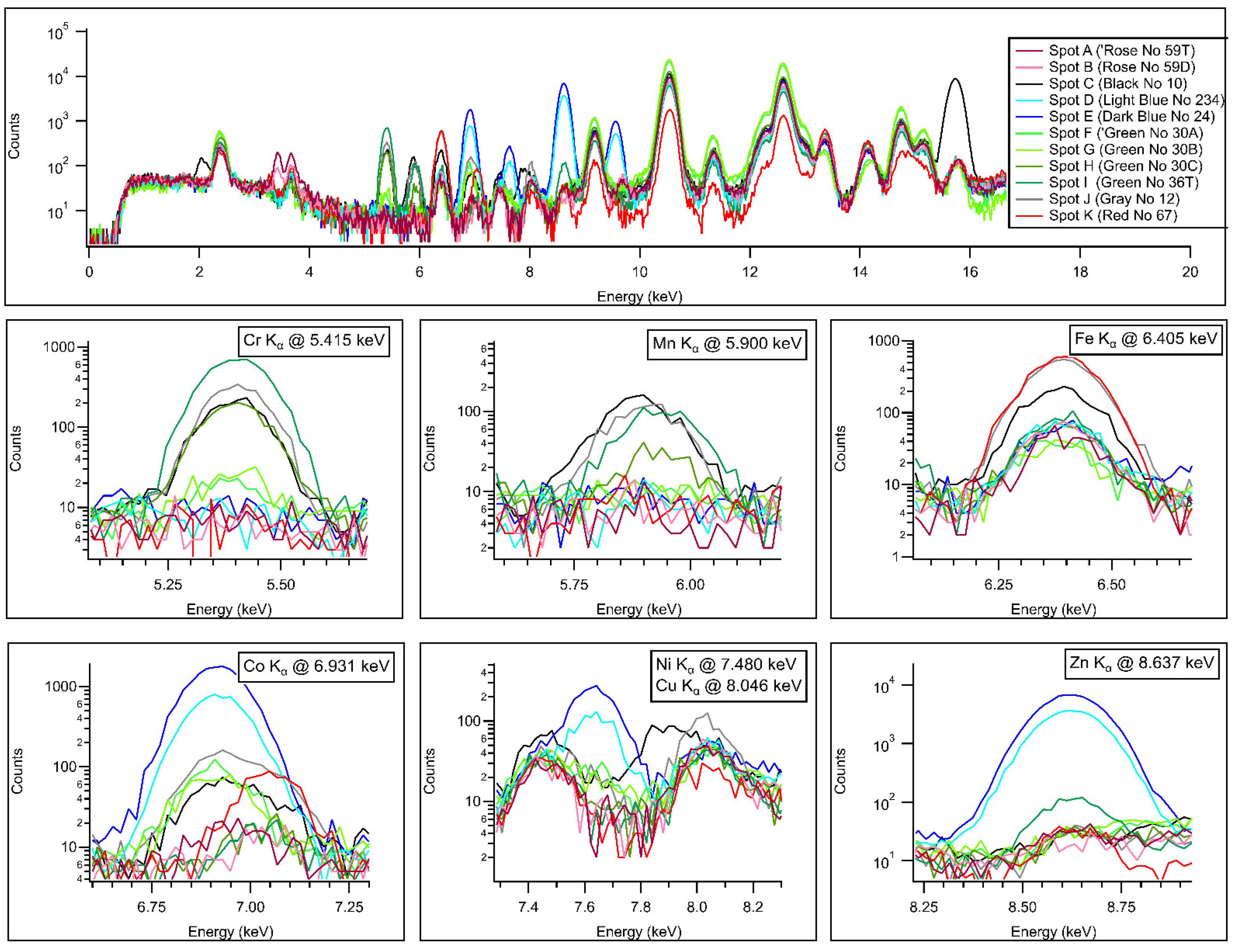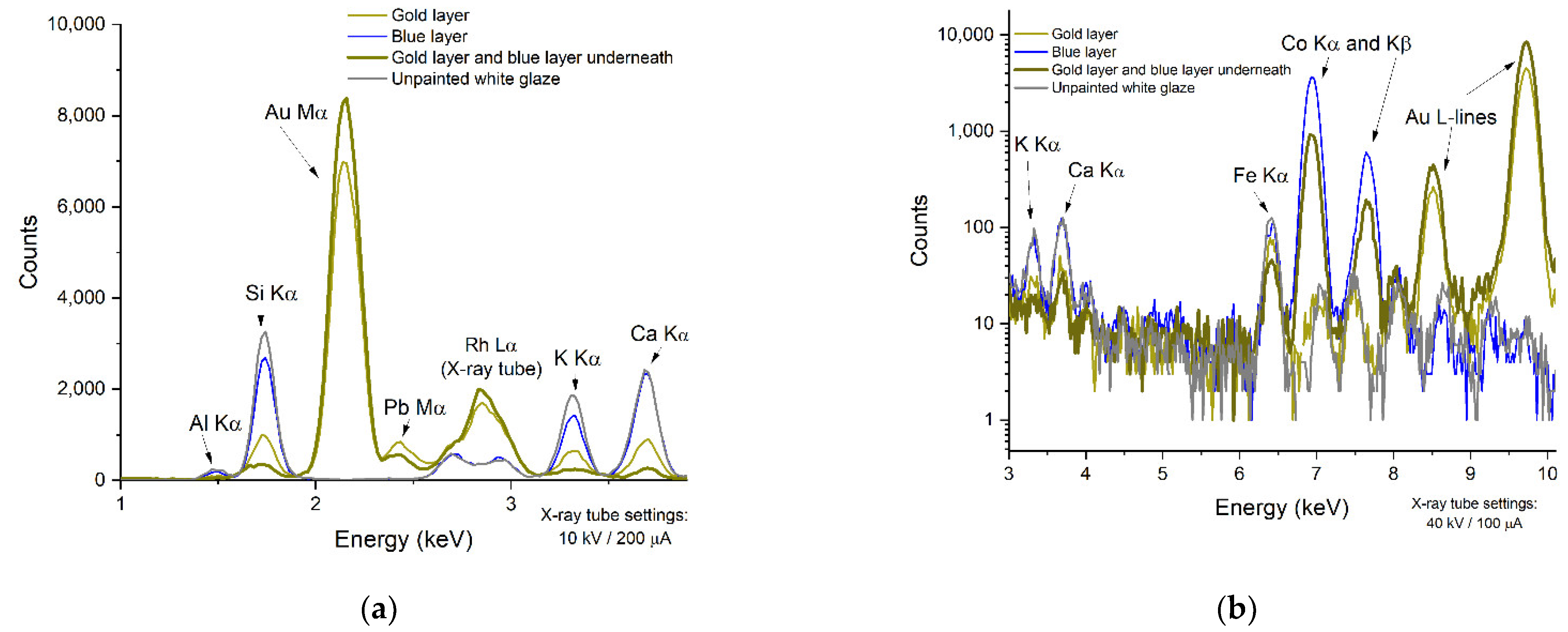Position-Sensitive Bulk and Surface Element Analysis of Decorated Porcelain Artifacts
Abstract
:1. Introduction
2. Materials and Methods
2.1. Benchmark Object
2.2. Geometry-Digitalization via 3D Structured-Light Scanning or Neutron Tomography
2.3. Visualization of the Decoration by Dual-Energy X-ray Imaging
2.4. Position-Sensitive Prompt-Gamma Activation Analysis (PGAI) for Bulk Characterization
2.5. XRF Technique as a Surface-Analytical Tool
3. Results and Discussion
4. Conclusions
Supplementary Materials
Author Contributions
Funding
Acknowledgments
Conflicts of Interest
References
- Leung, P.L.; Luo, H. A Study of Provenance and Dating of Ancient Chinese Porcelain by X-ray Fluorescence Spectrometry. X-ray Spectrom. 2000, 29, 34–38. [Google Scholar] [CrossRef]
- He, L. Chinese Ceramics: A New Comprehensive Survey from the Asian Art Museum of San Francisco; Rizzoli: New York, NY, USA, 2006; ISBN 978-0847819737. [Google Scholar]
- Pierson, S. The Pilgrim Art: Cultures of Porcelain in World History by Robert Finlay. China Rev. Int. 2012, 19, 582–586. [Google Scholar] [CrossRef]
- Chaffers, W. Marks and Monograms on European and Oriental Pottery and Porcelain, with Historical Notices of Each Manufactory; over 3500 Potters’ Marks and Illustrations, 7th ed.; Reeves and Turner: Nashville, TN, USA, 1908. [Google Scholar]
- Valenstein, S.G. A Handbook of Chinese Ceramics; Metropolitan Museum of Art: New York, NY, USA, 1989. [Google Scholar] [CrossRef]
- Dondi, M.; Ercolani, G.; Melandri, C.; Mingazzini, C.; Marsigli, M. Chemical Composition of Porcelain Stoneware Tiles and Its Influence on Microstructural and Mechanical Properties. InterCeram Int. Ceram. Rev. 1999, 48, 75–83. [Google Scholar]
- Neelmeijer, C.; Roscher, R. PIXE-RBS Survey of a Meissen Porcelain Snuff Box: First Version or Not? X-ray Spectrom. 2012, 41, 93–97. [Google Scholar] [CrossRef]
- Simsek Franci, G.; Colomban, P. On-Site Identification of Pottery with PXRF: An Example of European and Chinese Red Stonewares. Heritage 2021, 5, 88–102. [Google Scholar] [CrossRef]
- Fornacelli, C.; Volpi, V.; Ponta, E.; Russo, L.; Briano, A.; Donati, A.; Giamello, M.; Bianchi, G. Grouping Ceramic Variability with PXRF for Pottery Trade and Trends in Early Medieval Southern Tuscany. Preliminary Results from the Vetricella Case Study (Grosseto, Italy). Appl. Sci. 2021, 11, 11859. [Google Scholar] [CrossRef]
- Colomban, P.; Ngo, A.T.; Fournery, N. Non-Invasive Raman Analysis of 18th Century Chinese Export/Armorial Overglazed Porcelain: Identification of the Different Enameling Techniques. Heritage 2022, 5, 233–259. [Google Scholar] [CrossRef]
- Neelmeijer, C.; Pietsch, U.; Ulbricht, H. Eighteenth-Century Meissen Porcelain Reference Data Obtained By Proton-Beam Analysis (PIXE-PIGE). Archaeometry 2014, 56, 527–540. [Google Scholar] [CrossRef]
- LeMoine, J.B.; Halperin, C.T. Comparing INAA and PXRF Analytical Methods for Ceramics: A Case Study with Classic Maya Wares. J. Archaeol. Sci. Rep. 2021, 36, 102819. [Google Scholar] [CrossRef]
- Torrisi, L.; Venuti, V.; Crupi, V.; Silipigni, L.; Cutroneo, M.; Paladini, G.; Torrisi, A.; Havránek, V.; Macková, A.; La Russa, M.F.; et al. RBS, PIXE, Ion-Microbeam and SR-FTIR Analyses of Pottery Fragments from Azerbaijan. Heritage 2019, 2, 1852–1873. [Google Scholar] [CrossRef] [Green Version]
- Carter, S.; Clough, R.; Fisher, A.; Gibson, B.; Russell, B. Atomic Spectrometry Update: Review of Advances in the Analysis of Metals, Chemicals and Materials; Royal Society of Chemistry: London, UK, 2021; Volume 36, ISBN 0324532008. [Google Scholar]
- Molnár, G.L. Handbook of Prompt Gamma Activation Analysis; Springer: Berlin/Heidelberg, Germany, 2004; pp. 1–423. [Google Scholar]
- Hegewisch, M.; Daszkiewicz, M.; Schneider, G. (Eds.) Using PXRF for the Analysis of Ancient Pottery; Universität Berlin und der Humboldt-Universität zu Berlin: Berlin, Germany, 2021; ISBN 9783981968590. [Google Scholar]
- Bode, P. Kilogram Sample Analysis by Nuclear Analytical Techniques: Complementary Opportunities for the Mineral and Geosciences. Minerals 2021, 11, 443. [Google Scholar] [CrossRef]
- Kasztovszky, Z. Application of Prompt Gamma Activation Analysis to Investigate Archaeological Ceramics. Archeometria Műhely 2007, 2, 49–54. [Google Scholar]
- Dias, M.I.; Prudêncio, M.I.; Kasztovszky, Z.; Maróti, B.; Harsányi, I.; Flor, P. Nuclear Techniques Applied to Provenance and Technological Studies of Renaissance Majolica Roundels from Portuguese Museums Attributed to Della Robbia Italian Workshop. J. Radioanal. Nucl. Chem. 2017, 312, 205–219. [Google Scholar] [CrossRef]
- Domoney, K. X-ray Fluorescence (XRF) Analysis of Porcelain: Background Paper. Anal. Methods 2017, 9, 2371–2374. [Google Scholar] [CrossRef]
- Capobianco, G.; Sferragatta, A.; Lanteri, L.; Agresti, G.; Bonifazi, G.; Serranti, S.; Pelosi, C. ΜXRF Mapping as a Powerful Technique for Investigating Metal Objects from the Archaeological Site of Ferento (Central Italy). J. Imaging 2020, 6, 59. [Google Scholar] [CrossRef] [PubMed]
- De Pauw, E.; Tack, P.; Verhaeven, E.; Bauters, S.; Acke, L.; Vekemans, B.; Vincze, L. Microbeam X-ray Fluorescence and X-ray Absorption Spectroscopic Analysis of Chinese Blue-and-White Kraak Porcelain Dating from the Ming Dynasty. Spectrochim. Acta Part B At. Spectrosc. 2018, 149, 190–196. [Google Scholar] [CrossRef]
- Lin, C.; Meitian, L.; Youshi, K.; Changsheng, F.; Shanghai, W.; Qiuli, P.; Zhiguo, L.; Rongwu, L. The Study of Chemical Composition and Elemental Mappings of Colored Over-Glaze Porcelain Fired in Qing Dynasty by Micro-X-ray Fluorescence. Nucl. Instrum. Methods Phys. Res. Sect. B Beam Interact. Mater. At. 2011, 269, 239–243. [Google Scholar] [CrossRef]
- Alberti, R.; Crupi, V.; Frontoni, R.; Galli, G.; La Russa, M.F.; Licchelli, M.; Majolino, D.; Malagodi, M.; Rossi, B.; Ruffolo, S.A.; et al. Handheld XRF and Raman Equipment for the in Situ Investigation of Roman Finds in the Villa Dei Quintili (Rome, Italy). J. Anal. At. Spectrom. 2017, 32, 117–129. [Google Scholar] [CrossRef]
- Brongniart, A. Traité des Arts Céramiques ou des Poteries Considérées dans Leur Histoire, Leur Pratique et Leur Théorie; Wentworth Press: Paris, France, 1844. [Google Scholar]
- Calligaro, T.; Arean, L.; Pacheco, C.; Lemasson, Q.; Pichon, L.; Moignard, B.; Boust, C.; Bertrand, L.; Schoeder, S.; Thoury, M.; et al. A New 3D Positioner for the Analytical Mapping of Non-Flat Objects under Accelerator Beams. Nucl. Instrum. Methods Phys. Res. Sect. B Beam Interact. Mater. At. 2020, 467, 65–72. [Google Scholar] [CrossRef] [Green Version]
- RangeVision SMART Scanner. Available online: https://rangevision.com/en/products/smart/ (accessed on 23 June 2022).
- Volume Graphics VG Studio Max. Available online: http://www.volumegraphics.com (accessed on 23 June 2022).
- Fredenberg, E. Spectral and Dual-Energy X-ray Imaging for Medical Applications. Nucl. Instrum. Methods Phys. Res. Sect. A Accel. Spectrometers Detect. Assoc. Equip. 2018, 878, 74–87. [Google Scholar] [CrossRef]
- Bohr, N. Neutron Capture and Nuclear Constitution. Nature 1936, 137, 344–348. [Google Scholar] [CrossRef]
- Révay, Z.; Firestone, R.B.; Belgya, T.; Molnár, G.L. Prompt Gamma-Ray Spectrum Catalog. In Handbook of Prompt Gamma Activation Analysis; Molnár, G.L., Ed.; Kluwer Academic Publishers: Dordrecht, The Netherlands; Boston, MA, USA; London, UK, 2004; pp. 173–364. [Google Scholar]
- Fazekas, B.; Belgya, T.; Dabolczi, L.; Molnár, G.; Simonits, A. HYPERMET-PC: Program for Automatic Analysis of Complex Gamma- Ray Spectra. J. Trace Microprobe Tech. 1996, 14, 167–172. [Google Scholar]
- Simonits, A.; Östör, J.; Kálvin, S.; Fazekas, B. HyperLab: A New Concept in Gamma-Ray Spectrum Analysis. J. Radioanal. Nucl. Chem. 2003, 257, 589–595. [Google Scholar] [CrossRef]
- Révay, Z. Determining Elemental Composition Using Prompt γ Activation Analysis. Anal. Chem. 2009, 81, 6851–6859. [Google Scholar] [CrossRef]
- Govindaraju, K. 1995 working values with confidence limits for twenty-six crpg, anrt and iwg-git geostandards. Geostand. Newsl. 1995, 19, 22. [Google Scholar] [CrossRef]
- Shakhashiro, A.; Trinkl, A.; Törvenyi, A.; Zeiller, E.; Benesch, T.; Sansone, U. Report on the IAEA-CU-2006-06 Proficiency Test on the Determination of Major, Minor and Trace Elements in Ancient Chinese Ceramic; International Atomic Energy Agency (IAEA): Seibersdorf, Austria, 2006. [Google Scholar]
- Szentmiklósi, L.; Kis, Z.; Belgya, T.; Berlizov, A.N. On the Design and Installation of a Compton–Suppressed HPGe Spectrometer at the Budapest Neutron-Induced Prompt Gamma Spectroscopy (NIPS) Facility. J. Radioanal. Nucl. Chem. 2013, 298, 1605–1611. [Google Scholar] [CrossRef]
- Kis, Z.; Szentmiklósi, L.; Belgya, T. NIPS–NORMA Station—A Combined Facility for Neutron-Based Nondestructive Element Analysis and Imaging at the Budapest Neutron Centre. Nucl. Instrum. Methods Phys. Res. Sect. A Accel. Spectrometers Detect. Assoc. Equip. 2015, 779, 116–123. [Google Scholar] [CrossRef]
- Belgya, T.; Kis, Z.; Szentmiklósi, L.; Kasztovszky, Z.; Kudejova, P.; Schulze, R.; Materna, T.; Festa, G.; Caroppi, P.A. First Elemental Imaging Experiments on a Combined PGAI and NT Setup at the Budapest Research Reactor. J. Radioanal. Nucl. Chem. 2008, 278, 751–754. [Google Scholar] [CrossRef]
- Szentmiklósi, L.; Kis, Z.; Maróti, B. Integration of Neutron-Based Elemental Analysis and Imaging to Characterize Complex Cultural Heritage Objects. In Handbook of Cultural Heritage Analysis; D’Amico, S., Venuti, V., Eds.; Springer: Berlin/Heidelberg, Germany, 2022; Volume 1, pp. 239–272. [Google Scholar]
- Szentmiklósi, L.; Maróti, B.; Kis, Z.; Janik, J.; Horváth, L.Z. Use of 3D Mesh Geometries and Additive Manufacturing in Neutron Beam Experiments. J. Radioanal. Nucl. Chem. 2019, 320, 451–457. [Google Scholar] [CrossRef] [Green Version]
- Goorley, T.; James, M.; Booth, T.; Brown, F.; Bull, J.; Cox, L.J.; Durkee, J.; Elson, J.; Fensin, M.; Forster, R.A.; et al. Features of MCNP6. Ann. Nucl. Energy 2016, 87, 772–783. [Google Scholar] [CrossRef] [Green Version]
- Szentmiklósi, L.; Kis, Z.; Maróti, B.; Horváth, L.Z. Correction for Neutron Self-Shielding and Gamma-Ray Self-Absorption in Prompt-Gamma Activation Analysis for Large and Irregularly Shaped Samples. J. Anal. At. Spectrom. 2021, 36, 103–110. [Google Scholar] [CrossRef]
- Belgya, T. Prompt Gamma Activation Analysis at the Budapest Research Reactor. Phys. Procedia 2012, 31, 99–109. [Google Scholar] [CrossRef] [Green Version]
- Kasztovszky, Z.; Maróti, B.; Harsányi, I.; Párkányi, D.; Szilágyi, V. A Comparative Study of PGAA and Portable XRF Used for Non-Destructive Provenancing Archaeological Obsidian. Quat. Int. 2018, 468, 179–189. [Google Scholar] [CrossRef]
- Lins, S.A.B.; Manso, M.; Lins, P.A.B.; Brunetti, A.; Sodo, A.; Gigante, G.E.; Fabbri, A.; Branchini, P.; Tortora, L.; Ridolfi, S. Modular Ma-Xrf Scanner Development in the Multi-Analytical Characterisation of a 17th Century Azulejo from Portugal. Sensors 2021, 21, 1913. [Google Scholar] [CrossRef]
- Shugar, A.N. Handheld Macro-SRF Scanning: Development of Collimators for Sub-Mm Resolution. In Proceedings of the Fourth International Symposium on Analytical Methods in Philately; Lera, T., Barwis, J.H., Eds.; Smithsonian National Postal Museum: Washington, DC, USA, 2020; pp. 13–20. [Google Scholar]
- Tsuji, K.; Matsuno, T.; Takimoto, Y.; Yamanashi, M.; Kometani, N.; Sasaki, Y.C.; Hasegawa, T.; Kato, S.; Yamada, T.; Shoji, T.; et al. New Developments of X-ray Fluorescence Imaging Techniques in Laboratory. Spectrochim. Acta Part B At. Spectrosc. 2015, 113, 43–53. [Google Scholar] [CrossRef]
- Yang, J.; Zhang, Z.; Cheng, Q. Resolution Enhancement in Micro-XRF Using Image Restoration Techniques. J. Anal. At. Spectrom. 2022, 37, 750–758. [Google Scholar] [CrossRef]
- Brightspec BAxil XRF Evaluation Software Package. Available online: https://www.brightspec.be/brightspec/?q=node/31 (accessed on 23 June 2022).






| 1 | 2 | 3 | 4 | 5 | ||||||||||||
|---|---|---|---|---|---|---|---|---|---|---|---|---|---|---|---|---|
| Beam | Thermal | Cold | Thermal | Cold | Thermal | Cold | Thermal | Thermal | ||||||||
| m% | unc% | m% | unc% | m% | unc% | m% | unc% | m% | unc% | m% | unc% | m% | unc% | m% | unc% | |
| H | 130 ppm | 9 | 100 ppm | 6 | 130 ppm | 6 | 100 ppm | 6 | 220 ppm | 10. | 210 ppm | 6 | 100 ppm | 5 | 260 ppm | 7 |
| B | 60 ppm | 0.9 | 63 ppm | 0.8 | 59 ppm | 0.8 | 58 ppm | 1.0 | 121 ppm | 0.9 | 106 ppm | 0.9 | 110 ppm | 0.9 | 62 ppm | 1.0 |
| Na | 0.48 | 3.0 | 0.46 | 2.0 | 0.57 | 2.9 | 0.54 | 3.1 | 0.63 | 3.0 | 0.52 | 2.3 | 0.58 | 2.9 | 0.57 | 2.9 |
| Mg | 1.0 | 9.7 | 1.3 | 8.1 | ||||||||||||
| Al | 16.1 | 1.6 | 17.2 | 1.5 | 15.7 | 1.6 | 15.5 | 1.6 | 16 | 1.6 | 16 | 2.1 | 16 | 2.0 | 15.8 | 1.8 |
| Si | 29 | 1.6 | 28 | 1.6 | 29 | 1.6 | 29 | 1.7 | 29 | 1.7 | 29 | 1.9 | 28 | 1.7 | 29 | 1.7 |
| K | 2.4 | 1.9 | 2.4 | 1.9 | 2.4 | 2.0 | 2.3 | 1.9 | 2.4 | 1.9 | 2.5 | 2.0 | 2.4 | 2.3 | 2.5 | 3.1 |
| Ca | 2.5 | 3.0 | 2.7 | 2.5 | 2.6 | 3.1 | 2.5 | 2.6 | 2.6 | 2.9 | 2.6 | 2.8 | 2.4 | 2.6 | 2.6 | 3.6 |
| Ti | 110 ppm | 16.9 | 120 ppm | 9.0 | 120 ppm | 10.6 | 80 ppm | 22.0 | 140 ppm | 11.7 | 120 ppm | 10.4 | ||||
| Mn | 100 ppm | 9 | 100 ppm | 4.8 | ||||||||||||
| Fe | 0.24 | 9.3 | 0.24 | 4.1 | 0.20 | 12.1 | 0.25 | 6.5 | 0.23 | 8.0 | 0.21 | 7.3 | 0.22 | 4.9 | ||
| Cu | 0.11 | 9.0 | ||||||||||||||
| Co | 0.24 | 3.2 | 0.24 | 2.8 | 50 ppm | 17 | 30 ppm | 14.2 | 0.059 | 3.8 | ||||||
| Nd | 20 ppm | 16.8 | 30 ppm | 19 | ||||||||||||
| Gd | 3.9 ppm | 6.2 | 4 ppm | 9.4 | 3.8 ppm | 6.9 | 3.4 ppm | 7.3 | 4 ppm | 13.0 | 3.7 ppm | 6.2 | 1.8 ppm | 7.0 | 4.1 ppm | 5.2 |
| Au | 0.21 | 3.5 | ||||||||||||||
| 0 | 1 | 2 | 3 | 4 | 5 | |||||||
|---|---|---|---|---|---|---|---|---|---|---|---|---|
| m% | unc % | m% | unc % | m% | unc % | m% | unc % | m% | unc % | m% | unc % | |
| Al | 15.4 | 2.6 | 8.28 | 3.3 | 6.59 | 3.9 | 2.38 | 7.6 | 3.71 | 5.7 | 4.57 | 7.4 |
| Si | 29.5 | 1.0 | 42.2 | 0.7 | 35.9 | 0.8 | 22.6 | 0.9 | 20.1 | 1.0 | 4.6 | 2.4 |
| K | 1.74 | 1.7 | 3.61 | 1.1 | 2.36 | 1.3 | 1.97 | 1.0 | 0.616 | 3.2 | ||
| Ca | 2.89 | 1.0 | 3.04 | 1.0 | 2.78 | 1.1 | 2.49 | 1.2 | 1.42 | 1.4 | ||
| Ti | 0.089 | 14.7 | 0.0501 | 22.2 | 0.0711 | 14.9 | 0.0768 | 15.0 | 0.0534 | 18.4 | ||
| Mn | 0.0116 | 30.2 | 0.0822 | 8.4 | ||||||||
| Fe | 0.312 | 2.9 | 0.229 | 3.1 | 0.156 | 3.8 | 0.12 | 4.2 | 0.409 | 2.2 | 0.365 | 7.1 |
| Co | 3.64 | 0.5 | 0.0652 | 5.1 | 6.81 | 1.2 | ||||||
| Cu | 0.0107 | 10.3 | 0.0104 | 10.6 | 0.0166 | 7.8 | 0.0171 | 7.0 | 0.0191 | 6.3 | ||
| Sn | 0.0435 | 3.9 | 0.0319 | 4.7 | 0.0366 | 4.4 | 0.133 | 1.5 | 0.0382 | 4.2 | ||
| Au | 40.5 | 0.5 |
Publisher’s Note: MDPI stays neutral with regard to jurisdictional claims in published maps and institutional affiliations. |
© 2022 by the authors. Licensee MDPI, Basel, Switzerland. This article is an open access article distributed under the terms and conditions of the Creative Commons Attribution (CC BY) license (https://creativecommons.org/licenses/by/4.0/).
Share and Cite
Szentmiklósi, L.; Maróti, B.; Csákvári, S.; Calligaro, T. Position-Sensitive Bulk and Surface Element Analysis of Decorated Porcelain Artifacts. Materials 2022, 15, 5106. https://doi.org/10.3390/ma15155106
Szentmiklósi L, Maróti B, Csákvári S, Calligaro T. Position-Sensitive Bulk and Surface Element Analysis of Decorated Porcelain Artifacts. Materials. 2022; 15(15):5106. https://doi.org/10.3390/ma15155106
Chicago/Turabian StyleSzentmiklósi, László, Boglárka Maróti, Szabolcs Csákvári, and Thomas Calligaro. 2022. "Position-Sensitive Bulk and Surface Element Analysis of Decorated Porcelain Artifacts" Materials 15, no. 15: 5106. https://doi.org/10.3390/ma15155106
APA StyleSzentmiklósi, L., Maróti, B., Csákvári, S., & Calligaro, T. (2022). Position-Sensitive Bulk and Surface Element Analysis of Decorated Porcelain Artifacts. Materials, 15(15), 5106. https://doi.org/10.3390/ma15155106






